PriceSmart Bundle
Who Really Owns PriceSmart?
Understanding the ownership structure of a company is critical for investors and analysts alike. PriceSmart, a leading membership warehouse club operating in Latin America and the Caribbean, presents a compelling case study in corporate ownership. This analysis dives deep into the PriceSmart SWOT Analysis, exploring the evolution of its ownership from its founding to its current status as a publicly traded entity.
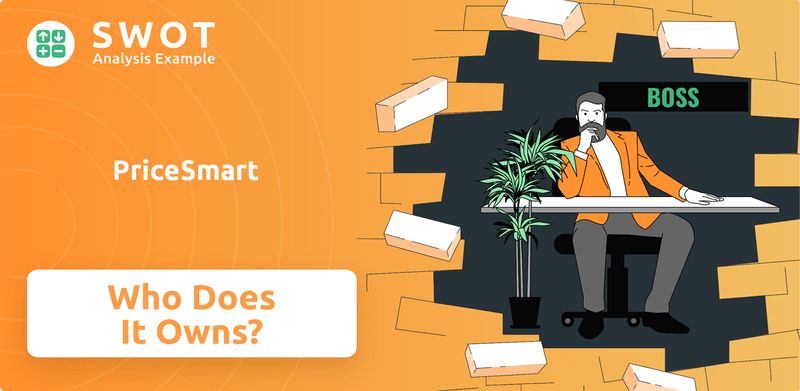
This exploration into PriceSmart ownership will reveal the key players shaping its destiny. We'll examine the influence of major shareholders, the impact of institutional investors, and the role of individual investors. Discover how the company's ownership structure affects its strategic decisions, financial performance, and overall market position. Learn about the PriceSmart company's corporate structure and the individuals who hold significant sway over its future, including insights into the PriceSmart stock and its performance.
Who Founded PriceSmart?
The origins of PriceSmart ownership can be traced back to its founding in 1994. The company was established by a team of experienced retail entrepreneurs, setting the stage for its unique business model. This initial ownership structure was crucial in shaping the company's strategic direction and operational approach.
Sol Price, Robert Price, and Giles Bateman were the key figures behind the creation of PriceSmart. Sol Price, a renowned figure in the retail sector, brought extensive experience from his previous ventures, including FedMart and Price Club. Robert Price, Sol's son, and Giles Bateman complemented this with their expertise, contributing to the development of the warehouse club concept for international markets.
The early ownership of PriceSmart reflects a blend of family influence and strategic investment. While specific equity breakdowns from the company's inception are not readily available in public records, the Price family's significant role suggests they held a substantial stake. This ownership structure was fundamental in guiding the company's initial expansion and operational strategies.
Sol Price, Robert Price, and Giles Bateman founded PriceSmart in 1994. Sol Price had a significant background in retail. Robert Price and Giles Bateman were key to the international warehouse club concept.
Early funding likely came from the founders and potentially angel investors. These early agreements were crucial for the company's expansion. They would have included provisions for reinvestment and operational control.
The founding team's vision shaped the membership-based warehouse model. This model was specifically tailored for the Latin American and Caribbean markets. The initial distribution of control ensured alignment with their retail philosophy.
The early years focused on establishing a strong presence in new markets. This expansion was supported by the initial ownership structure. The focus was on building a solid foundation for future growth and market penetration.
The Price family, particularly Sol and Robert, held significant influence. Their experience in the warehouse club model was invaluable. Their ownership stakes likely reflected their foundational role.
The initial ownership structure was designed to ensure operational control. This control was essential for implementing the founders' vision. It allowed for strategic decision-making aligned with their goals.
The early ownership structure of PriceSmart, involving the founders and potentially a limited number of early investors, set the stage for the company's growth. The vision for a membership-based warehouse model, tailored for specific markets, was directly reflected in the initial distribution of control. This early phase of PriceSmart's brief history was crucial for establishing its operational framework and guiding its strategic direction. Understanding who owns PriceSmart and the initial ownership dynamics provides insight into the company's early strategic decisions and its approach to expansion. As of 2024, the company continues to operate with a focus on its core membership model, with a significant presence in Latin America and the Caribbean, reflecting the enduring impact of its founding ownership.
PriceSmart was founded by Sol Price, Robert Price, and Giles Bateman in 1994.
- Sol Price brought extensive retail experience.
- Robert Price and Giles Bateman contributed to the warehouse club concept.
- The Price family likely held substantial equity stakes.
- Early ownership involved initial capital from founders and investors.
PriceSmart SWOT Analysis
- Complete SWOT Breakdown
- Fully Customizable
- Editable in Excel & Word
- Professional Formatting
- Investor-Ready Format
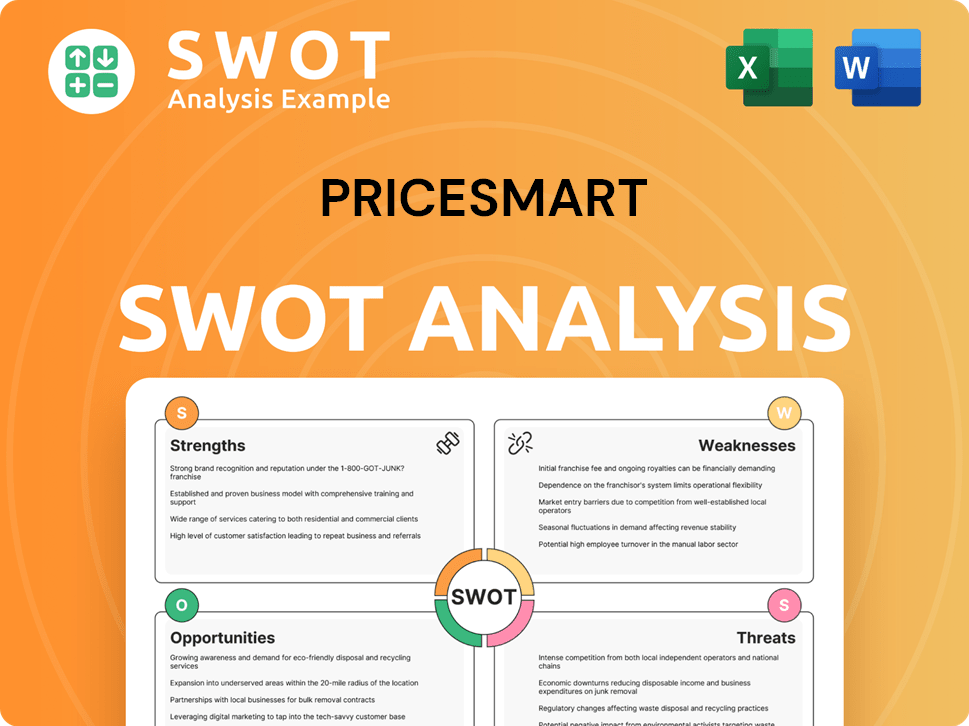
How Has PriceSmart’s Ownership Changed Over Time?
The transformation of PriceSmart, Inc. (NASDAQ: PSMT) from a private entity to a publicly traded company was a pivotal event in its ownership history. The initial public offering (IPO) facilitated a wider distribution of ownership, allowing public shareholders to participate in the company's growth. This shift marked the beginning of an evolution in the company's ownership structure, which has since incorporated a variety of institutional investors, mutual funds, and individual shareholders.
Since its IPO, the ownership of PriceSmart has been characterized by a diverse composition. The company's shareholders now include a mix of large institutional investment firms and mutual funds. This diversification reflects the company's growth and its increasing presence in the market. The influence of these major stakeholders is significant, particularly in corporate governance and strategic decision-making.
| Event | Impact on Ownership | Timeline |
|---|---|---|
| Initial Public Offering (IPO) | Broadened ownership base, allowing public investment. | Historical |
| Growth of Institutional Investment | Increased influence of institutional investors on corporate governance. | Ongoing |
| Market Fluctuations | Changes in shareholding by institutional investors due to market sentiment. | Ongoing |
As of early 2025, major stakeholders in PriceSmart typically include large institutional investment firms and mutual funds. Firms like Vanguard Group Inc. and BlackRock Inc. are often among the top institutional holders. These firms often hold substantial percentages of outstanding shares, influencing corporate governance through their voting power. Changes in their holdings can reflect shifts in market sentiment or strategic adjustments by these large funds. This institutional ownership significantly affects company strategy and governance. For further insights into the company's business model, consider reading about the Revenue Streams & Business Model of PriceSmart.
PriceSmart's ownership structure is a mix of institutional and individual investors. The company's stock symbol is PSMT. Major shareholders significantly influence corporate decisions.
- Institutional investors play a key role.
- Ownership has evolved since the IPO.
- Understanding major shareholders is crucial.
- The stock is publicly traded.
PriceSmart PESTLE Analysis
- Covers All 6 PESTLE Categories
- No Research Needed – Save Hours of Work
- Built by Experts, Trusted by Consultants
- Instant Download, Ready to Use
- 100% Editable, Fully Customizable
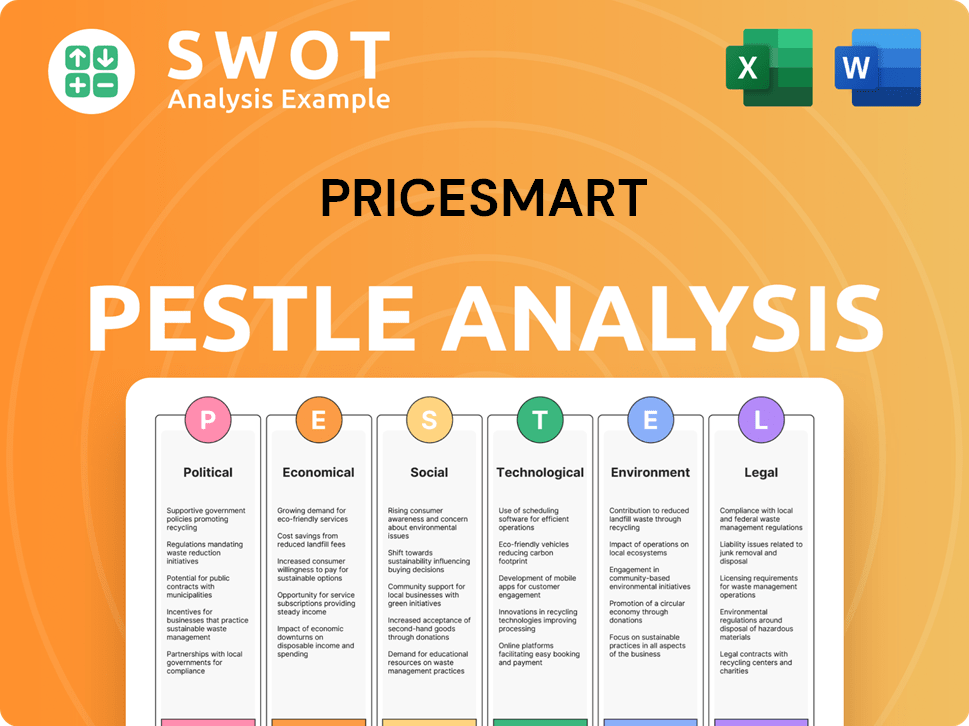
Who Sits on PriceSmart’s Board?
The Board of Directors of PriceSmart Inc. oversees the company's strategic direction and ensures accountability to its shareholders. The board typically includes a combination of independent directors and those who may represent significant shareholder interests or have executive roles within the company. Robert Price, one of the founders, has historically held a significant position on the board, representing the founding family's continued influence. Independent directors bring external perspectives and are essential for good corporate governance. As of the latest filings, the board composition is regularly updated to reflect the evolving needs of the company and its shareholders. Information on the current board members can be found in the company's annual reports and proxy statements.
The board's composition and its committees are crucial for effective corporate governance. These committees, such as the audit, compensation, and nominating committees, play a vital role in overseeing financial reporting, executive compensation, and board nominations. The specific responsibilities and activities of these committees are detailed in the company's corporate governance guidelines, which are available on the PriceSmart investor relations website. The board's structure is designed to balance the interests of all shareholders and ensure the long-term sustainability of the company. The Growth Strategy of PriceSmart is influenced by the board's decisions.
| Director Name | Position | Affiliation |
|---|---|---|
| Robert Price | Director | Founder |
| Sherry Bahrambeygui | Director | Independent |
| Michael J. Callahan | Director | Independent |
The voting structure for PriceSmart, as a publicly traded company on NASDAQ (symbol: PSMT), generally adheres to a one-share-one-vote principle, meaning each common share typically entitles its holder to one vote on corporate matters. This standard structure ensures that voting power is proportional to the economic interest held by shareholders. While there are no widely reported instances of dual-class shares or special voting rights that grant outsized control to specific individuals or entities, the collective voting power of large institutional investors can be substantial. Institutional investors, such as mutual funds and pension funds, collectively hold a significant percentage of the company's outstanding shares. The influence of major institutional shareholders through their significant holdings remains a key factor in decision-making within the company.
PriceSmart is a publicly traded company, meaning it is owned by its shareholders. The ownership structure includes institutional investors, individual investors, and insiders. The stock symbol for PriceSmart is PSMT.
- The company's major shareholders are primarily institutional investors.
- Robert Price, as a founder, holds a significant position.
- Understanding the ownership structure is crucial for investors.
- PriceSmart's financial reports provide detailed information on shareholders.
PriceSmart Business Model Canvas
- Complete 9-Block Business Model Canvas
- Effortlessly Communicate Your Business Strategy
- Investor-Ready BMC Format
- 100% Editable and Customizable
- Clear and Structured Layout
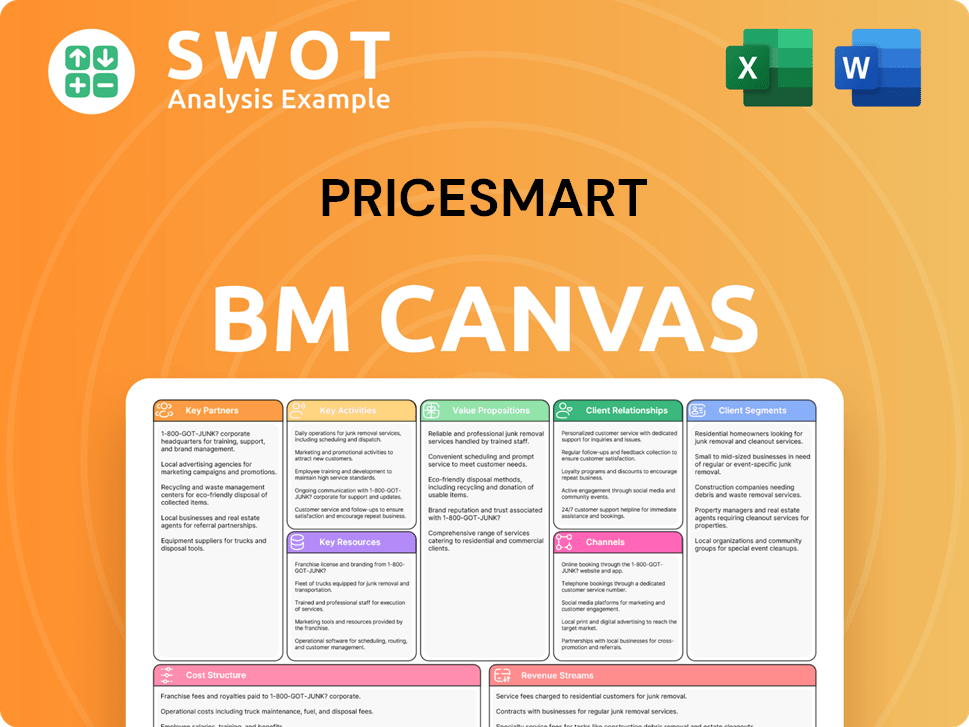
What Recent Changes Have Shaped PriceSmart’s Ownership Landscape?
In the past three to five years (2022-2025), the ownership structure of PriceSmart has remained relatively stable, with no major shifts reported through significant share buybacks, secondary offerings, or mergers and acquisitions. The company has concentrated on strengthening its presence within its established markets in Latin America and the Caribbean. This focus is evident in its financial reports and communications with investors. The stability in the PriceSmart ownership structure reflects a strategic emphasis on operational efficiency and expansion within existing territories.
Industry trends suggest a rise in institutional ownership across many public companies, and PriceSmart is likely experiencing a similar trend. Large asset managers are continually accumulating shares for their passive and active funds. This trend may lead to a gradual decrease in individual retail investor ownership. The continued involvement of key figures such as Robert Price, who is from the founding family, suggests a degree of continuity in the company's strategic direction. Public statements from the company and analysts have focused on operational expansion, supply chain resilience, and digital transformation initiatives. The company's consistent dividend policy also influences its appeal to certain investor segments. For further insights, consider exploring the Competitors Landscape of PriceSmart.
| Metric | Value | Year |
|---|---|---|
| Stock Symbol | PSMT | 2024 |
| Headquarters | San Diego, CA | 2024 |
| Founder | Sol Price | Historical |
PriceSmart company continues to focus on its core business model of operating membership warehouse clubs. The company's financial performance and stock price history are key factors influencing investor behavior. Understanding the PriceSmart owner and PriceSmart shareholders is essential for anyone looking to invest in the stock. The current strategies of PriceSmart stock management and investor relations provide insights into the company's future direction.
Institutional investors hold a significant percentage of PriceSmart's outstanding shares. These include large asset management firms and investment funds. The exact percentages can fluctuate based on market activity and investment decisions. Investors can find detailed information on major shareholders in the company's annual reports and SEC filings.
Insider ownership, which includes shares held by executives and board members, provides insight into the alignment of interests between management and shareholders. The level of insider ownership may influence investor confidence. This data can be found in the company's proxy statements and other SEC filings.
The PriceSmart stock price history reflects the company's financial performance and market sentiment. Investors can track the stock's performance through financial news outlets and brokerage platforms. The stock's performance is influenced by factors like revenue growth, profitability, and overall market conditions.
PriceSmart investor relations provides resources for shareholders and potential investors. These resources include financial reports, press releases, and investor presentations. Information about PriceSmart financial reports and PriceSmart annual report can be found on the company's website. Investors can contact the investor relations department for specific inquiries.
PriceSmart Porter's Five Forces Analysis
- Covers All 5 Competitive Forces in Detail
- Structured for Consultants, Students, and Founders
- 100% Editable in Microsoft Word & Excel
- Instant Digital Download – Use Immediately
- Compatible with Mac & PC – Fully Unlocked
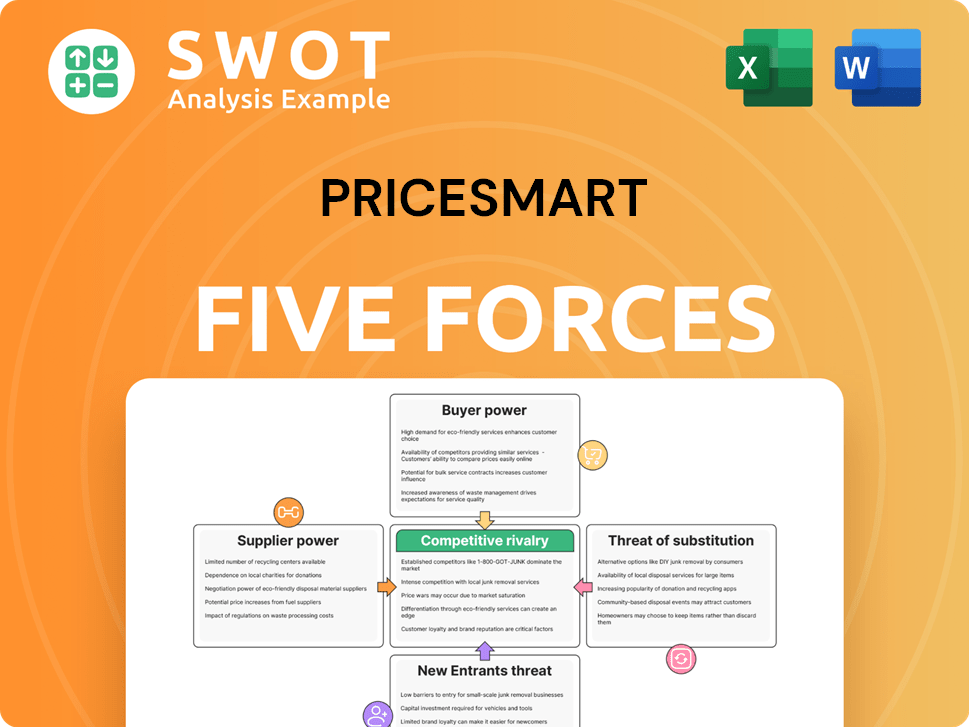
Related Blogs
- What are Mission Vision & Core Values of PriceSmart Company?
- What is Competitive Landscape of PriceSmart Company?
- What is Growth Strategy and Future Prospects of PriceSmart Company?
- How Does PriceSmart Company Work?
- What is Sales and Marketing Strategy of PriceSmart Company?
- What is Brief History of PriceSmart Company?
- What is Customer Demographics and Target Market of PriceSmart Company?
Disclaimer
All information, articles, and product details provided on this website are for general informational and educational purposes only. We do not claim any ownership over, nor do we intend to infringe upon, any trademarks, copyrights, logos, brand names, or other intellectual property mentioned or depicted on this site. Such intellectual property remains the property of its respective owners, and any references here are made solely for identification or informational purposes, without implying any affiliation, endorsement, or partnership.
We make no representations or warranties, express or implied, regarding the accuracy, completeness, or suitability of any content or products presented. Nothing on this website should be construed as legal, tax, investment, financial, medical, or other professional advice. In addition, no part of this site—including articles or product references—constitutes a solicitation, recommendation, endorsement, advertisement, or offer to buy or sell any securities, franchises, or other financial instruments, particularly in jurisdictions where such activity would be unlawful.
All content is of a general nature and may not address the specific circumstances of any individual or entity. It is not a substitute for professional advice or services. Any actions you take based on the information provided here are strictly at your own risk. You accept full responsibility for any decisions or outcomes arising from your use of this website and agree to release us from any liability in connection with your use of, or reliance upon, the content or products found herein.